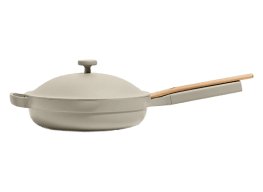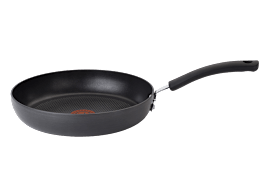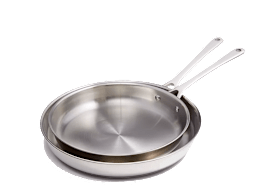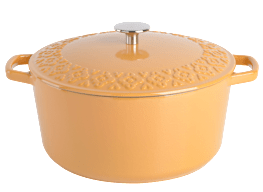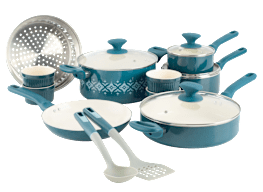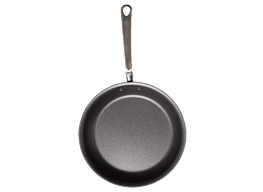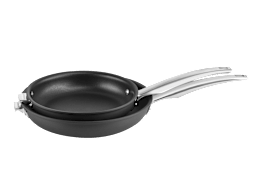Cleaning Cast-Iron Pans Is Easier Than You Think
Here’s how to keep your skillets spotless, according to the experts
When you shop through retailer links on our site, we may earn affiliate commissions. 100% of the fees we collect are used to support our nonprofit mission. Learn more.

Cast-iron pans have been around for centuries, yet the myth persists that they are difficult to clean and care for. Oh, the irony! If they weren’t easy to care for, how could they last for generations, with the pan you inherited from your grandmother being just as good (or better) as one you buy today?
Part of the mystique has to do with so-called seasoning, the step you take to keep a cast-iron pan slick by periodically baking a thin layer of vegetable oil into its surface. Back in the day, many cast-iron pans were shipped unseasoned, or bare, so once you brought one home you had to season it yourself before using it. While that was not a daunting task, it did take some time and dedication.
How Do You Keep a Cast-Iron Pan Seasoned?
If you bought your pan unseasoned, which is rare these days, here’s how to season it:
• Wash and dry it thoroughly.
• Rub it all over with oil and buff it with a soft cloth so that the pan doesn’t look oily.
• Put the pan in a 450° F oven, upside down so oil doesn’t pool, and heat for 30 minutes. (Ovens are preferred over stovetops because they provide more even heat.)
• Repeat two or three more times to establish that first good layer of seasoning.
Then cook your first dish!
You can keep your pan seasoned by using the same method when you think it’s beginning to look dry. But you don’t need as many repetitions. If you find that your cast iron is getting dull or the food is starting to stick, apply a thin layer of cooking oil to the surface of your cookware with a cloth or lint-free paper towel (inside and out, including the handles). Bake your cookware upside down in a 450° F oven for 1 hour and allow it to cool in the oven, says Stubblefield.
Can You Wash Your Cast-Iron Pan With Soap?
This is another perennial question. If wiping out the pan with a little water and a paper towel doesn’t remove stuck-on food, it’s okay to use a little dish soap and water. “Using a little soap won’t remove the seasoning,” says Tara Casaregola, who oversees our cookware tests.
If that doesn’t work, there’s another way to loosen the stuck-on stuff. "For tougher messes, add a little water to your pan and simmer for a minute or two," says Cindy Fisher, CR’s lead cookware tester. Let it cool a bit and then scrape the pan with a spatula (metal or plastic), drain the water, give it a brisk wash off, dry it thoroughly, and apply a thin layer of oil. If that still doesn’t work, and it usually does, scrub the skillet with coarse salt and a splash of water, then wipe dry and swipe with oil. In fact, whenever you wash your pan be sure to dry it completely so that it doesn’t develop rust.
How to Remove Rust From a Cast-Iron Pan
First scrub the rusty sections with a mesh scrub sponge (not steel wool because it’s too rough), then wash it with warm, soapy water. “Next, dry your cast iron and add a very thin layer of cooking oil to the entire surface,” says Stubblefield. Then heat it in the oven as outlined above.
Can You Ruin a Cast-Iron Pan?
“You’re not going to ruin your pan, unless you do something truly stupid,” say the folks at Butter Pat, who provide this reassurance along with lots of other helpful information on their website. So what shouldn’t you do? Don’t plunge a hot pan into cold water or put it in the dishwasher. Don’t be tempted to store your leftovers in a cast-iron pan in the refrigerator. Not only can the food cause the seasoning to deteriorate, but putting a hot pan in the fridge can crack the glass shelves or the pan itself. And never put your cast-iron pan in the oven on the self-cleaning cycle. "For the general cleaning of a cast-iron pan, it’s overkill to put your pan in the oven during a self-clean cycle," says Fisher. Doing that may also ruin all the seasoning you tried so hard to build up.
How Do You Clean Enameled Cast Iron?
If you have an enameled cast-iron pan, there’s no need to worry about seasoning. You can clean it with plain dish soap, scrubbing gently with a sponge (avoid metal scrubbers, which can scratch the enamel). But again, avoid putting it in the dishwasher because the combination of hot water and harsh detergent can degrade the inside and outside coatings. And don’t plunge a hot pan into cold water, because the pan can warp. Instead, let it return to room temperature before cleaning.
Best Cast-Iron Pans From Our Tests
Here are the best uncoated cast-iron pans from CR’s tests, listed alphabetically and not in performance order. To find more information on how to clean a particular pan, check your owners manual or the manufacturers website. Most makers of cast-iron pans have lots of helpful information. Cast iron still not for you? Check our full cookware ratings and recommendations.
















